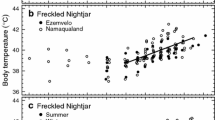Summary
-
1.
In a study of thermoregulation in the greater glider, a small arboreal marsupial with large gliding membranes, metabolic rate (MR), skin and deep body temperature (T sk,T b), and respiratory and total evaporative heat loss (E ex,E tot) were measured in relation to ambient temperature (T a).
-
2.
Although the surface area is twice that of marsupials of similar body weight, MR was not significantly different from the average marsupial metabolic rate. This must be attributed to an excellent thermal insulation and behavioural factors.
-
3.
AtT a above the thermoneutral point, at 20°C, the greater glider became hyperthermic.T b increased from 35.4°C at 20°CT a to 39.1°C at 40°C. At 30°C, 55% of MR was dissipated by evaporation. This proportion increased to 105% at 35°C and 132% of MR at 40°C. The increase inE tot was accompanied by intense licking of extremities and the ventral body surface.E ex dissipated only 12% of MR at 40°C irrespective of an 8-fold increase in respiratory frequency from a basal value of 18 breaths·min−1.
-
4.
It is concluded that the greater glider can utilize its gliding membranes to reduce heat losses by increasing the insulative layer around the body surface. At highT a, a clear contrast between the inefficient use of water for evaporative thermolytic processes, mainly salivation, and the limited availability of water in its arboreal habitat becomes evident.
Similar content being viewed by others
References
Bartholomew GA, Leitner P, Nelson JE (1964) Body temperature, oxygen consumption, and heart rate in three species of Australian flying foxes. Physiol Zool 37:179–198
Bradley SR, Deavers DR (1980) A re-examination of the relationship between thermal conductance and body weight in mammals. Comp Biochem Physiol 65A:465–476
Brown JH, Lasiewski RC (1972) Metabolism of weasels: the cost of being long and thin. Ecology 53:939–943
Carpenter RE, Graham JB (1967) Physiological responses to temperature in the long-nosed bat,Leptonycteris sanborni. Comp Biochem Physiol A 22:709–722
Dawson TJ, Hulbert AJ (1970) Standard metabolism, body temperature, and surface area of Australian marsupials. Am J Physiol 218:1233–1238
Degabriele R, Dawson TJ (1979) Metabolism and heat balance in an arboreal marsupial, the koala (Phascolarctos cinereus). J Comp Physiol 134:293–301
Drorbaugh JE, Fenn WO (1955) A barometric method for measuring ventilation in newborn infants. Pediatrics 16:81–87
Epstein MAF, Epstein RA (1978) A theoretical analysis of the barometric method for measurement of tidal volume. Respir Physiol 32:105–120
Fleming MR (1980) Thermoregulation and torpor in the sugar glider,Petaurus breviceps (Marsupialia: Petauridae). Aust J Zool 28:521–534
Foley WJ (1983) Maintenance nitrogen and energy requirements of the greater glider. Bull Aust Mammal Soc (in press)
Gagge AP, Hardy JD, Rapp GM (1969) Proposed standard system of symbols for thermal physiology. J Appl Physiol 27:439–446
Gonzales RR, Kluger MJ, Hardy JD (1971) Parttional calorimetry of the New Zealand white rabbit at temperatures 5–35°C. J Appl Physiol 31:728–734
Hales JRS, Brown GD (1974) Net energetic and thermoregulatory efficiency during panting in the sheep. Comp Biochem Physiol A 49:413–422
Heller HC (1980) What is a primitive thermoregulatory system? In: Schmidt-Nielsen K, Bolis L, Taylor CR (ed) Comparative physiology: primitive mammals. Cambridge University Press, Cambridge, pp 120–128
Iversen JA (1972) Basal energy metabolism of mustelids. J Comp Physiol 81:341–344
Jacky JP (1980) Barometric measurement of tidal volume: effects of pattern and nasal temperature. J Appl Physiol 49:319–325
Kamau JMZ, Johansen K, Maloiy GMO (1979) Thermoregulation and standard metabolism of the slender mongoose (Herpestes sanguineus). Physiol Zool 52:594–602
Kinnear A, Shield JW (1975) Metabolism and temperature regulation in marsupials. Comp Biochem Physiol 52:235–245
Kleiber M (1961) The fire of life. An introduction to animal energetics. Wiley and Sons, New York
Mackay RJ (1963) Bio-medical telemetry. Wiley and Sons, New York
McLean JA (1972) On the calciulation of heat production from open-circuit calorimetric measurements. Br J Nutr 27:597–600
Noll-Banholzer U (1979) Body temperature, oxygen consumption, evaporative water loss and heart rate in the fennec. Comp Biochem Physiol A 62:585–592
Author information
Authors and Affiliations
Rights and permissions
About this article
Cite this article
Rübsamen, K., Hume, I.D., Foley, W.J. et al. Implications of the large surface area to body mass ratio on the heat balance of the greater glider (Petauroides volans: Marsupialia). J Comp Physiol B 154, 105–111 (1984). https://doi.org/10.1007/BF00683223
Accepted:
Issue Date:
DOI: https://doi.org/10.1007/BF00683223




